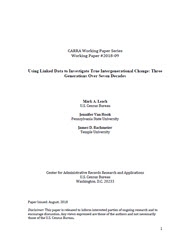Using Linked Data to Investigate True Intergenerational Change: Three Generations Over Seven Decades
Using Linked Data to Investigate True Intergenerational Change: Three Generations Over Seven Decades
Abstract
It is widely thought that immigrants and their families undergo profound cultural and socioeconomic changes as a consequence of coming into contact with U.S. society, but the way this occurs remains unclear and controversial due in large part to data limitations. In this paper, we provide proof of concept for analyses using linked data that allow us to compare outcomes across more “exact” family generations. Specifically, we are able to follow immigrant parents and their children and grandchildren across seven decades using census and survey data from 1940 to 2014. We describe the data and linkage methodology, evaluate the representativeness of the linked sample, test a method for adjusting for biases that arise from non-representative linkages, and describe the size, diversity, and socioeconomic characteristics of the linked sample. We demonstrate that large sample sizes of linked data will likely permit us to compare several national origin groups across multiple generations.
Others in Series
Working Paper
Working Paper
Working Paper




